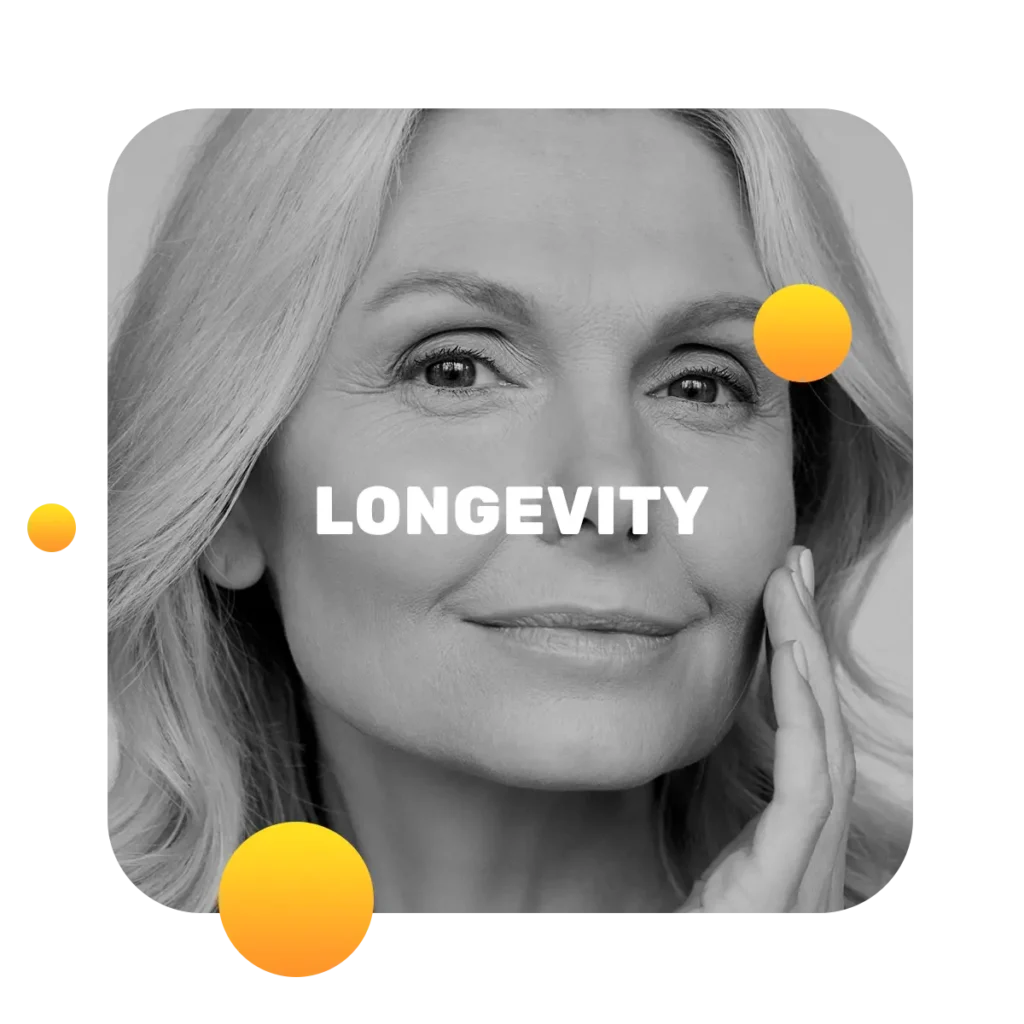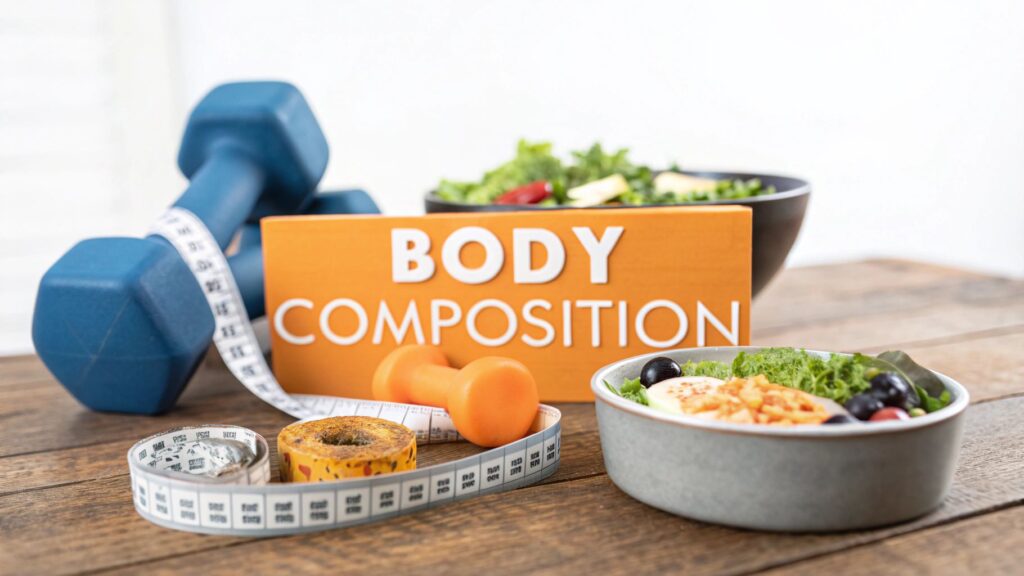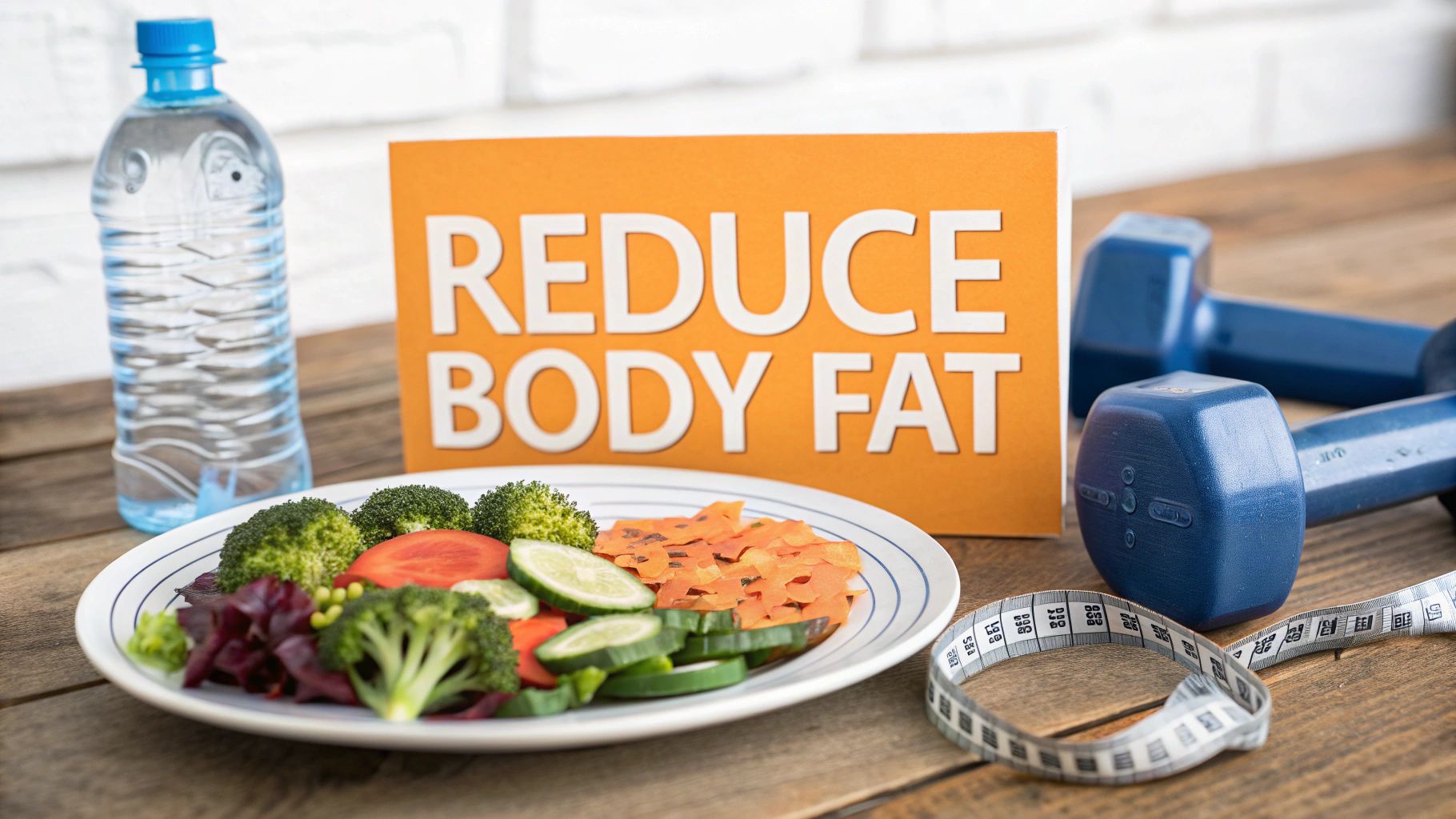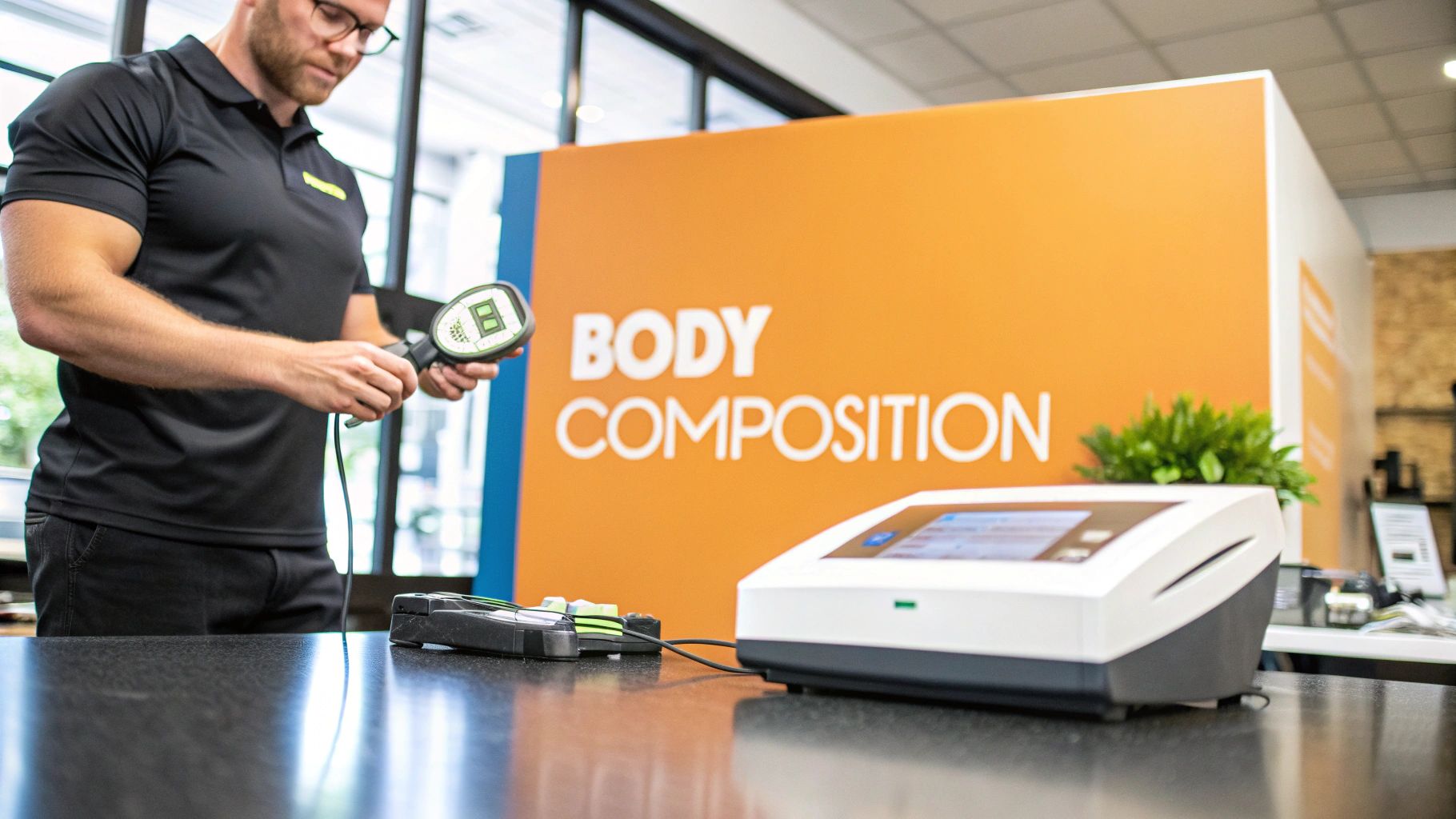If you want to truly transform your body, you have to stop obsessing over the number on the scale. The real goal is improving your body composition—the ratio of lean mass to fat mass. The most proven way to do this is by combining smart resistance training with a high-protein diet, often while maintaining a slight caloric deficit. This approach tells your body to build valuable muscle while burning stored fat for energy.
Understanding Body Composition Beyond The Scale
When you step on a standard bathroom scale, it tells you one thing: your total weight. That single number is a terrible way to track progress. It’s often deceptive and can be incredibly frustrating because it lumps everything together—fat, muscle, bone, and water.
This is where understanding body composition becomes a complete game-changer. It forces you to shift your focus from a meaningless number to what actually matters for your health, performance, and how you look in the mirror.
Think about it. Two people can be the exact same height and weight yet have completely different physiques. One might have a higher body fat percentage and less muscle, appearing soft and out of shape. The other could be lean and athletic. That second person not only looks more toned but has a faster metabolism and far better health markers. This is the core of how to improve body composition; you're building a stronger, more efficient body, not just a lighter one.
What Makes Up Your Body?
Your body is made of two main types of mass:
- Fat Mass: This is the fat you can see and pinch (subcutaneous) and the dangerous fat around your organs (visceral). Some fat is essential, but too much is a well-known risk factor for a host of health problems.
- Lean Mass: This is everything else—your muscles, bones, organs, and water. Building lean muscle is a top priority because it’s metabolically active, meaning it torches calories around the clock, even when you’re resting.
This chart gives you a clear visual of how these components break down, showing exactly why focusing on one number from the scale is a flawed strategy.

As you can see, lean mass makes up the bulk of your body weight. Its health and function are what you should be focused on.
How To Measure Your Body Composition
So, if the scale is out, what should you be using instead? Luckily, technology has made getting an accurate read on your body composition easier than ever.
The demand for better tools is exploding. The global market for body composition analyzers was projected to hit $956.2 million by 2025. This surge isn't just a fad; it reflects a massive shift toward more precise and meaningful health tracking. You can explore the full market research to see how technology is driving this change.
To get a real sense of where you stand, you need a reliable measurement tool. Here’s a quick look at the most common methods available.
Comparing Methods for Measuring Body Composition
Choosing the right tool to measure your body composition can feel overwhelming. This table breaks down the most common methods, helping you understand their accessibility, cost, and what they're best used for so you can pick the one that fits your goals and budget.
| Method | How It Works | Accessibility & Cost | Best For |
|---|---|---|---|
| DEXA Scan | Uses low-dose X-rays to provide a detailed breakdown of bone, fat, and lean mass. | Low accessibility; typically found in clinics. Can cost $100-$200+ per scan. | The "gold standard" for accuracy; ideal for a highly precise baseline measurement. |
| BIA Smart Scale | Sends a tiny, harmless electrical current through the body to estimate fat and muscle percentages. | High accessibility; widely available online and in stores. Cost ranges from $30-$150. | Tracking trends over time. The day-to-day numbers can fluctuate, but the long-term average is very useful. |
| Skinfold Calipers | Measures the thickness of subcutaneous fat at several specific sites on the body. | High accessibility; very affordable ($10-$20). | Low-cost tracking, but accuracy is highly dependent on the skill of the person taking the measurements. |
Each method has its place, but for most people, consistency is more important than perfect accuracy.
The key is to find a method you can stick with. Whether it's a BIA smart scale you use weekly or progress photos you take every month, consistent tracking will give you a much clearer picture of your success than fixating on the number on a traditional scale.
Crafting Your Nutrition Plan for Real Results

While your training provides the spark for change, your nutrition plan is the raw material your body uses to rebuild and reshape itself. This is where so many people get tripped up. They think they need to follow a painfully restrictive diet to see any real progress.
The truth is, sustainable body recomposition is built on a foundation of smart, strategic fueling—not starvation.
Forget the all-or-nothing mindset. The real goal is to create a slight calorie deficit to encourage fat loss while supplying enough high-quality protein to protect, and even build, precious muscle mass. It's a delicate balance, but it's the key to making real, lasting changes to your physique.
The Calorie Conundrum: Finding Your Sweet Spot
To lose fat, you have to consume fewer calories than you burn. That part is simple. However, diving into a massive calorie deficit is a surefire way to lose muscle and grind your metabolism to a halt.
Your body is smart. If it senses a famine, it will start sacrificing metabolically expensive muscle tissue to conserve energy. This is the exact opposite of what you want.
Instead, aim for a modest deficit of 200-500 calories below your daily maintenance level. This gentle approach signals to your body that it’s safe to tap into fat stores for energy without panicking and breaking down muscle. Think of it as a subtle nudge, not a drastic shove.
This controlled deficit is enough to produce steady fat loss of about 0.5 to 1 pound per week—a rate that’s perfect for preserving lean mass. Anything faster often comes at the cost of muscle, completely undermining your efforts.
Protein: The Non-Negotiable Pillar of Recomposition
When you’re in a calorie deficit, protein isn’t just important; it's your number one priority. Getting enough protein is the single most powerful nutritional tool for preventing muscle loss while you’re shedding fat. Research consistently shows that active individuals need significantly more protein than sedentary people.
For anyone focused on body recomposition, a target of 1.6 to 2.2 grams of protein per kilogram of body weight (or about 0.7 to 1.0 grams per pound) is the gold standard. This high intake provides the amino acids needed to repair muscle tissue damaged during training and keep your body in a prime state for building.
A 2022 meta-analysis concluded that adults should consume nearly twice the standard RDA of protein—around 1.5 g/kg of body weight—to augment muscle strength when combined with resistance training. This highlights how crucial higher protein intake is for anyone actively trying to change their physique.
Meeting this goal is easier than you think. It's all about making smart swaps and prioritizing protein at every meal.
- Breakfast: Instead of a bagel with cream cheese, go for Greek yogurt with berries or scrambled eggs with spinach.
- Lunch: Swap a pasta dish for a large salad topped with a double portion of grilled chicken or chickpeas.
- Snacks: Instead of reaching for chips, have a protein shake, a handful of almonds, or some beef jerky.
Nutrient Timing: Maximizing Your Workout Window
While your total daily intake matters most, what you eat around your workouts can give you a significant edge. Smart nutrient timing helps optimize your performance in the gym, kickstart recovery, and ensure your muscles have what they need, right when they need it most.
Pre-Workout Fuel:
About 60-90 minutes before you train, eat a meal rich in easily digestible carbs with some protein. This tops off your energy stores and gives your muscles a head start on recovery. A banana with a scoop of whey protein or a small bowl of oatmeal works perfectly.
Post-Workout Recovery:
After your workout, your muscles are primed to soak up nutrients. Consuming a fast-digesting protein source, like a whey isolate shake, within an hour or two helps kickstart the muscle repair process. While the "anabolic window" isn't as short as we once thought, providing protein soon after training is still a best practice for recovery.
Beyond the Basics for Accelerated Results
Once you have your calories and protein dialed in, you can start exploring other tools to support your journey. For some, integrating specific therapies can help break through plateaus and optimize hormonal function, which is critical for both losing fat and gaining muscle.
For individuals looking to enhance their fat-burning potential, exploring different options can be beneficial. You can learn more about how certain peptides for weight loss work in our detailed guide.
By focusing on a modest calorie deficit, prioritizing high protein intake, and timing your nutrients strategically, you build a powerful and sustainable nutrition plan. This approach transforms food from a source of stress into your greatest ally. It's not about restriction; it's about intelligent fueling for real, lasting results.
Designing A Training Program That Builds Muscle

While nutrition lays the foundation for change, your training program is the spark that tells your body what to build. A smart workout routine acts as the catalyst for muscle growth and fat loss, completely reshaping your physique.
At the core of any effective plan is one non-negotiable principle: progressive overload. It's a simple concept—you have to consistently and gradually increase the challenge you place on your muscles. If you’re lifting the same weight for the same reps, week in and week out, your body will adapt and see no reason to change further.
Think of progressive overload as the language your muscles understand. You have to force them to get stronger, compelling them to adapt and grow more resilient. This is the absolute cornerstone of improving your body composition with exercise.
Choosing Your Training Split
Here's a secret: the best workout split is the one you can actually stick to consistently. Your schedule, how quickly you recover, and what you enjoy all matter. Don't get paralyzed trying to find the "perfect" program; find one that fits your life.
Here are a few popular and battle-tested options:
- Full-Body Split (3 days/week): Ideal for beginners or anyone tight on time. You hit every major muscle group in each workout, maximizing stimulation with fewer gym days. A typical week could be workouts on Monday, Wednesday, and Friday.
- Push/Pull/Legs (PPL) Split (3-6 days/week): This approach groups muscles by how they function. One day is for "pushing" moves (chest, shoulders, triceps), another for "pulling" (back, biceps), and a third for legs. It allows for more focused volume on each muscle group.
- Upper/Lower Split (4 days/week): Just like it sounds, you split your body in half. You’ll have two upper-body days and two lower-body days each week, offering a fantastic balance between training frequency and recovery.
No matter what you pick, consistency is the real engine of your results. Choose a split, give it an honest effort for at least 8-12 weeks, and focus on getting stronger.
The Foundation Of Muscle Growth
To achieve hypertrophy—the scientific term for muscle growth—your workouts need to be structured. Just going through the motions won't cut it. For most exercises, aiming for 3 to 4 sets of 8 to 12 repetitions has proven to be the sweet spot for building muscle.
This rep range creates the perfect mix of mechanical tension and metabolic stress needed to signal growth. The last couple of reps in every set should be tough; you should feel like you could maybe manage one or two more, but not five.
Make compound movements the heart of your routine. Lifts like squats, deadlifts, bench presses, and overhead presses work multiple muscle groups at once, delivering the most bang for your buck. These are the big, efficient exercises for building overall strength and size.
You can't sculpt a pebble. You need to build the stone first. Prioritize getting strong on the big, compound lifts. The aesthetic improvements will follow.
After you've hit your compound lifts, you can add isolation exercises like bicep curls or tricep extensions to bring up specific muscles. For those ready to push their results even further, understanding how to support this intense training is crucial. You can learn more about maximizing muscle gains with peptide therapies in our dedicated guide.
The Cardio Question: HIIT vs LISS
Cardio is a fantastic tool for torching fat, but it must be used strategically so it doesn't sabotage your muscle-building efforts. The two main schools of thought are High-Intensity Interval Training (HIIT) and Low-Intensity Steady-State (LISS).
| Cardio Type | Description | Best For |
|---|---|---|
| HIIT | Short bursts of all-out effort (like 30 seconds of sprinting) followed by brief recovery periods. | Time-crunched workouts and elevating your metabolic rate for hours after you're done. |
| LISS | Sustained, low-to-moderate intensity exercise (like a 30-45 minute brisk walk or bike ride). | Lower-impact fat burning that is less taxing on your system and easier to recover from. |
So, which one is better? The best answer is: use both.
A balanced approach almost always wins. You could incorporate 1-2 HIIT sessions per week on your non-lifting days and add 20-30 minutes of LISS (like walking on an incline treadmill) after your weight training. This combination helps you burn fat effectively without draining your energy for strength gains and recovery. It's a balanced blueprint that creates the perfect environment for your body to shed fat and build lean muscle.
How to Track Progress and Make Smart Adjustments

A solid diet and training plan is your launchpad, but smart, consistent tracking is the guidance system that keeps you from flying off course. Honestly, one of the biggest mistakes I see people make is obsessing over the number on the bathroom scale. It’s a surefire recipe for frustration and almost always paints an incomplete, and often misleading, picture of what’s really happening.
Think about it. When you’re genuinely improving your body composition, you’re often gaining dense, lean muscle while shedding puffy, lighter body fat. The scale might not move an inch—or it might even creep up. This can trick you into thinking your hard work isn't paying off. That’s precisely why you need a multi-faceted tracking system to see the full story.
Building Your Progress Dashboard
To get a true 360-degree view, you need to pull together a few different data points. I like to think of it like a business dashboard; you’d never judge a company’s health by a single number, so why would you do that with your own body?
Here are the tools you absolutely need in your arsenal to track your body composition improvements:
- Body Measurements: Grab a flexible tape measure and log key areas like your waist, hips, chest, arms, and thighs. A shrinking waist measurement paired with stable or growing arm measurements is an undeniable sign of a successful body recomposition.
- Progress Photos: Every four weeks, snap photos from the front, side, and back. For the love of consistency, use the same lighting, location, and time of day. The visual changes you’ll see in pictures are often more motivating than any number on a spreadsheet.
- Performance Logs: Keep a detailed log of your workouts. Are you lifting heavier? Squeezing out more reps with the same weight? This is hard evidence that you're getting stronger and building muscle—a core component of your goal.
These methods, when combined, tell a powerful story. People are catching on, and the demand for better tracking tools has exploded. The global market for human body composition scales was on track to hit $500 million by 2025, with related software growing at a 9.0% CAGR. This signals a massive consumer shift toward wanting more detailed insights beyond just body weight. You can dig into these market trends to see just how much demand there is for smarter tracking solutions.
Interpreting Your Data and Making Adjustments
After you’ve been gathering data for a few weeks, it's time to step back and analyze. The goal isn't just to collect numbers; it's to use them to make smart, calculated decisions.
First, don't panic over small, day-to-day fluctuations. Water retention, what you ate the night before, and how well you slept can all cause temporary shifts. You need to look for the overall trend over at least a two-to-four-week period.
If your progress genuinely stalls for more than two weeks in a row—meaning your measurements, photos, and gym performance all flatline—it’s time to make a small, calculated change. Do not throw your entire plan out the window.
Let's walk through a real-world scenario I see all the time:
You’ve been in a 300-calorie deficit for six weeks. Your weight loss has ground to a halt, your measurements haven't budged in two weeks, and you’re feeling sluggish in the gym. This is a classic plateau.
Instead of making a drastic, panicked cut to your calories, your first move should be a small tweak. You could try reducing your daily intake by another 100-150 caloriesor add one extra cardio session per week. The key is to make just one change, stick with it for another two weeks, and then re-evaluate your data. This methodical approach turns a frustrating plateau into a valuable learning opportunity, keeping you on the path to long-term success.
Lifestyle Habits That Drive Success
The hours you put into your nutrition and training are absolutely critical, but they're just one piece of the puzzle. What you do in the other 20+ hours of the day is where your lifestyle habits take over, and they can either supercharge your results or completely derail your progress.
I’ve seen it time and again: someone hits a frustrating plateau not because their diet is wrong or their workouts are weak, but because their habits outside the gym are actively working against them. This is where you can find a massive competitive edge on your body composition journey.
Prioritize High-Quality Sleep
Let's get one thing straight: sleep isn't a luxury. It's a non-negotiable biological demand for anyone serious about changing their body. When you're in deep sleep, your body flips the switch to repair mode, pumping out growth hormone to mend muscle tissue and keep your metabolism humming.
Skimping on rest throws that whole system into chaos. Just one bad night can spike cortisol (the stress hormone that loves to store fat) and crank up ghrelin (the "I'm starving" hormone), all while tanking leptin (the hormone that tells you you're full). This hormonal mess leaves you hungrier, more susceptible to cravings, and less efficient at burning fat.
To get your sleep on track, build a solid wind-down routine. An hour before bed, dim the lights, put the phone away, and maybe take a warm shower. The idea is to send a clear signal to your body that it's time to power down, making sure you get the 7-9 hours of quality rest needed for real muscle repair and fat loss.
Manage Your Stress Levels
Chronic stress is the silent physique killer. When you're constantly on edge, your body is swimming in cortisol. While it’s useful in a pinch, persistently high cortisol levels are a recipe for muscle breakdown and an increase in visceral fat—that nasty, dangerous fat that wraps around your organs.
And stress doesn't just come from big, dramatic life events. A demanding job, poor sleep, or even a diet that's too aggressive can all push your cortisol into the red zone. This creates a vicious cycle where all your hard work in the kitchen and the gym feels like it’s getting you nowhere.
A few simple stress-management tools can make a world of difference:
- Mindful Breathing: Seriously, just five minutes of slow, deep belly breathing can bring acute stress levels way down.
- Daily Walks: A 15-20 minute walk outside, especially in nature, is a proven cortisol crusher.
- Scheduled Downtime: Block out time in your calendar for things you genuinely enjoy that have zero to do with work or fitness.
Don’t underestimate the cumulative damage of daily stressors. Learning to manage your body’s stress response is just as crucial as tracking your macros or training volume. It’s a fundamental part of the body composition puzzle.
The Power of Hydration and Daily Movement
Finally, let’s talk about two of the simplest yet most overlooked habits: staying hydrated and just moving more. Water is essential for almost every metabolic process you can think of, from shuttling nutrients to your muscles to flushing out waste. Dehydration tanks your performance, slows your metabolism, and can even trick your brain into thinking you're hungry. Aim for at least 8-10 glasses a day.
Beyond your scheduled workouts, your total daily movement—known as Non-Exercise Activity Thermogenesis (NEAT)—is a huge factor in your total energy burn. NEAT is every calorie you burn doing things that aren't formal exercise.
Think of it as your secret weapon, a kind of "invisible" cardio that keeps your metabolism fired up 24/7. Simple tweaks can dramatically boost your NEAT and help you torch more fat without ever stepping on a treadmill.
- Take the stairs, not the elevator.
- Park at the far end of the parking lot.
- Pace around when you're on a phone call.
- Get up and stretch every hour if you have a desk job.
These small, consistent actions really compound over time, making a massive difference in your overall energy balance. When you master these core lifestyle habits—sleep, stress, hydration, and NEAT—you create an environment where your body can finally respond optimally to your diet and training. You're ensuring your hard work actually pays off.
Your Blueprint for Lasting Body Composition Change
Real transformation doesn’t happen in a 30-day challenge. It's forged by building a sustainable lifestyle. The journey to a better body composition is a marathon, not a sprint, and it stands on the pillars we've covered: smart nutrition, progressive training, consistent tracking, and solid habits. Patience will always beat a frantic chase for perfection.
Try shifting your focus away from the mirror and onto performance. Aim to lift heavier, feel more energetic, or recover faster. This creates a powerful feedback loop that actually makes the process enjoyable and keeps you in the game for the long haul.
For those ready to fine-tune their hormonal environment for even better results, you can explore our advanced guide on top supplements to boost HGH levels.
The key takeaway is simple: Consistency trumps intensity. Small, daily efforts compounded over time are what build an exceptional physique and lasting health.
This commitment truly pays off. Fitness programs that use personalized body composition analysis see client retention rates as high as 89%—far above what standard gyms achieve. It's proof that tracking real change, not just a number on the scale, fuels long-term dedication. You can discover more about how data-driven approaches support fitness goals and keep people motivated for the journey ahead.
Got Questions? We’ve Got Answers
Even with the best plan in hand, questions are bound to pop up. Let's tackle some of the most common ones we hear from people who are just getting serious about transforming their body composition.
Can You Really Build Muscle and Lose Fat at the Same Time?
Yes, you absolutely can. This holy grail of fitness is called body recomposition, and it’s the most efficient path for two specific groups: total beginners to weight training and anyone getting back into it after a long layoff. Their bodies are incredibly primed to respond to a new training stimulus.
It’s a delicate balancing act, though. To pull it off, you need a high-protein diet, a very slight calorie deficit (or eating right at your maintenance level), and a non-negotiable resistance training program. The scale might move slower than if you were on an aggressive "cut" or "bulk," but the end result is far more impressive—a sustainable, complete physique transformation.
Seriously, How Much Protein Do I Need?
If you’re actively training to improve your body composition, those generic protein guidelines you see everywhere just won't cut it. The science is crystal clear: a higher intake is non-negotiable to protect your hard-earned muscle during a diet and to provide the raw materials for new growth.
The sweet spot for most people is 1.6 to 2.2 grams of protein per kilogram of body weight (that’s about 0.7 to 1.0 grams per pound). So, if you weigh 150 pounds, you should be shooting for 105 to 150 grams of quality protein every single day.
Think of protein as your body’s insurance policy against muscle loss. Without enough of it, a calorie deficit sends a signal to your body to burn valuable muscle for energy, completely undermining all the hard work you’re putting in at the gym.
Is Cardio an Absolute Must for Fat Loss?
While fat loss is ultimately governed by a calorie deficit, thinking of cardio as "optional" is leaving a massive advantage on the table. It’s not strictly mandatory to lose weight, but it's an incredibly powerful tool for accelerating the process.
The main job of cardio is to jack up your total daily energy expenditure. This makes creating that necessary calorie deficit much easier without having to starve yourself or cut your food intake to miserable levels.
A smart approach involves a mix of both High-Intensity Interval Training (HIIT) and lower-intensity, steady-state (LISS) cardio. This one-two punch will not only torch more fat and boost your heart health but will do so without derailing your recovery and strength gains from lifting.
Ready to optimize every aspect of your body composition journey? Elite Bioscience offers tailored hormone, peptide, and vitamin therapies to support your goals. Our third-party tested products are prescribed by doctors and delivered directly to your door, giving you the tools to build muscle, burn fat, and elevate your health. Explore your options at https://elitebioscience.co.







